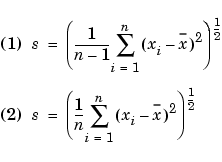

| MATLAB Function Reference |   |
Syntax
Definition
There are two common textbook definitions for the standard deviation s of a data vector X.


and  is the number of elements in the sample. The two forms of the equation differ only in
is the number of elements in the sample. The two forms of the equation differ only in  versus
versus  in the divisor.
in the divisor.
Description
s = std(X),
where X is a vector, returns the standard deviation using (1) above. The result s is the square root of an unbiased estimator of the variance of the population from which X is drawn, as long as X consists of independent, identically distributed samples.
If X is a matrix, std(X) returns a row vector containing the standard deviation of the elements of each column of X. If X is a multidimensional array, std(X) is the standard deviation of the elements along the first nonsingleton dimension of X.
s = std(X,flag)
for flag = 0, is the same as std(X). For flag = 1, std(X,1) returns the standard deviation using (2) above, producing the second moment of the sample about its mean.
s = std(X,flag,dim)
computes the standard deviations along the dimension of X specified by scalar dim. Set flag to 0 to normalize Y by n-1; set flag to 1 to normalize by n.
Examples
See Also
corrcoef, cov, mean, median, var
 | startup | stem |  |
© 1994-2005 The MathWorks, Inc.